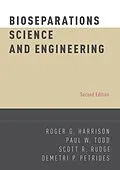Designed for undergraduates, graduate students, and industry practitioners, Bioseparations Science and Engineering fills a critical need in the field of bioseparations. Current, comprehensive, and concise, it covers bioseparations unit operations in unprecedented depth. In each of the chapters, the authors use a consistent method of explaining unit operations, starting with a qualitative description noting the significance and general application of the unit operation. They then illustrate the scientific application of the operation, develop the required mathematical theory, and finally, describe the applications of the theory in engineering practice, with an emphasis on design and scaleup. Unique to this text is a chapter dedicated to bioseparations process design and economics, in which a process simular, SuperPro Designer® is used to analyze and evaluate the production of three important biological products. New to this second edition are updated discussions of moment analysis, computer simulation, membrane chromatography, and evaporation, among others, as well as revised problem sets. Unique features include basic information about bioproducts and engineering analysis and a chapter with bioseparations laboratory exercises. Bioseparations Science and Engineering is ideal for students and professionals working in or studying bioseparations, and is the premier text in the field.
Autorentext
Roger G. Harrison is Professor in the College of Engineering at the University of Oklahoma. Scott R. Rudge is Technical Leader at RMC Pharmaceutical Solutions, Inc. Paul W. Todd is Chief Scientist at Techshot, Inc. Demetri P. Petrides is President of Intelligen, Inc.
Zusammenfassung
Designed for undergraduates, graduate students, and industry practitioners, Bioseparations Science and Engineering fills a critical need in the field of bioseparations. Current, comprehensive, and concise, it covers bioseparations unit operations in unprecedented depth. In each of the chapters, the authors use a consistent method of explaining unit operations, starting with a qualitative description noting the significance and general application of the unit operation. They then illustrate the scientific application of the operation, develop the required mathematical theory, and finally, describe the applications of the theory in engineering practice, with an emphasis on design and scaleup. Unique to this text is a chapter dedicated to bioseparations process design and economics, in which a process simular, SuperPro Designer is used to analyze and evaluate the production of three important biological products. New to this second edition are updated discussions of moment analysis, computer simulation, membrane chromatography, and evaporation, among others, as well as revised problem sets. Unique features include basic information about bioproducts and engineering analysis and a chapter with bioseparations laboratory exercises. Bioseparations Science and Engineering is ideal for students and professionals working in or studying bioseparations, and is the premier text in the field.
Inhalt
Table of Contents Preface Chapter 1: Introduction to Bioproducts and Bioseparations Chapter 2: Analytical Methods and Bench-Scale Preparative Bioseparations Chapter 3: Cell Lysis and Flocculation Chapter 4: Filtration Chapter 5: Sedimentation Chapter 6: Extraction Chapter 7: Liquid Chromatography and Adsorption Chapter 8: Precipitation Chapter 9: Crystallization Chapter 10: Evaporation Chapter 11: Drying Chapter 12: Bioprocess Design and Economics
